

A Comparative Study on Antimicrobial Activity of Vigna unguiculata And Cynodon dactylon
Soumallya Chakraborty
, Somenath Bhattacharya
Rohan Pal
Sanjit Mandal
, Dr. Arin Bhattacharjee
Biswas
Chiranjit Mandal
Dr. Amitava Roy
Department of Pharmaceutical Technology, Global College of Pharmaceutical Technology, Nadia, West Bengal,
Department of Pharmaceutical Technology, Brainware University, Barasat , Kolkata , West Bengal, India

Principal, Department of Pharmaceutical Technology, Global College of Pharmaceutical Technology, Nadia, West Bengal, India
Abstract: Extract from different parts of medicinal plant contains lots of phytochemicals and helps to cure different types of diseases. Vigna unguiculata and Cynodon dactylon both are annual herbs and found all over the country. Both annual herbs are numerous used in Ayurveda, Unani and Siddha medicines. Vigna unguiculata is a leguminous plant and contain various phytochemicals like alkaloids, flavonoids, Amino acid, phenols, and phytic acid. Vigna unguiculata extract have been reported to cure different type of diseases like anthelmintic activity, antibacterial activity, antimicrobial activity, antidiabetic activity, antiviral and antifungal activity, antioxidant activity ,hypocholesteerolemic activity and hypolipidemic activites. Extracts from different parts of Cynodon dactylon are widely used to prevent different kinds of diseases like antiviral and antimicrobial activity, against snake bites, gout and rheumatic affection, anthelmintic activity, anti inflammatory activity, reduce burning sensation, hyperdipsia, haematuria, leprosy, bronchitis, piles, asthma, enlargement of the spleen, tumors, dysentery, diarrhoea, conjunctivitis, vomiting etc due to the lot of phytochemical likes flavonoids, alkaloids, glycosides, terpenoids, saponins, resins, tannins, reducing sugar, phytosterols, proteins, carbohydrates, volatile oil and fixed oils presents in the plant.
Keywords: Cynodon dactylon, Vigna unguiculata, Antimicrobial Activity, Cowpea, Black eye pea, Durba.
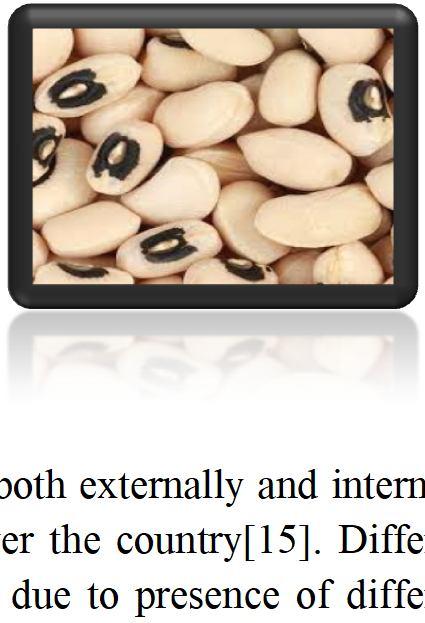
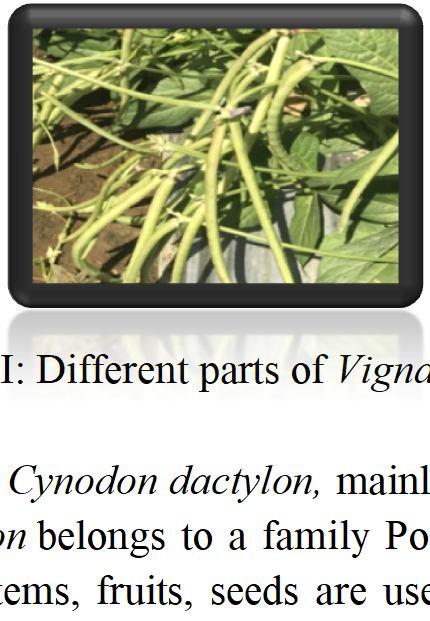
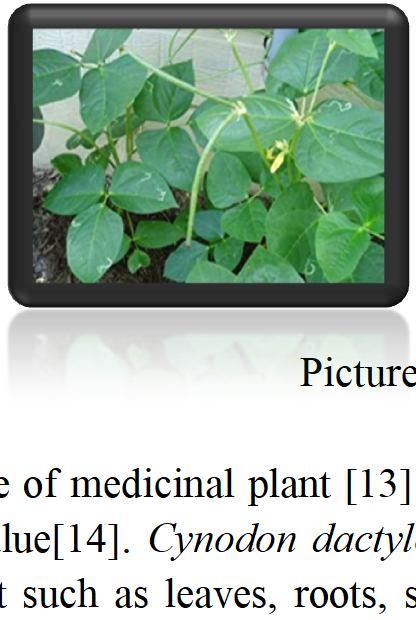
I. INTRODUCTION
Vigna unguiculata is largely produced and used for household consumption in Africa [1] and very commomly known as Cowpea or black eye pea [2]. It is a leguminous plant and belongs to a family Papilonaceae. The most important part of Vigna unguiculata is its leaf and seed which are source of numerous chemical constituents like alkanoids, flavonoids, amino acid, phenol, phytic acid, etc [3,4] as well as having potassium, iron, zinc, calcium, selenium, sodium, copper and potential sources of vitamin A and C [5]. Sandy soil with rich source of organic matter and minerals are the suitable place for the growth of the plant[6]. Different parts extract shows various medicinal activities like antioxidant, antifungal, antisickling, antidiabetic, antibacterial, hypolipidemic, hypocholesteerolemic, antimalarial, anthelmintic, thrombolytic activity[7,8]. Plants have strong tap and lateral roots with nodules helps to fix atmospheric nitrogen in soil. V. unguiculata contains a bunch white, yellow, blue or purple colour self fertilized flowers on the leaf axils. Green, brown or purple colour pods varies in length from 8 to 15 cm with straight or slightly beak or pointed beak tips. Pod contains green, black, brown,white, red, mottled and spotted seed averagely 1 10 seeds in a row[9 12].
Picture I: Different parts of Vigna unguiculata
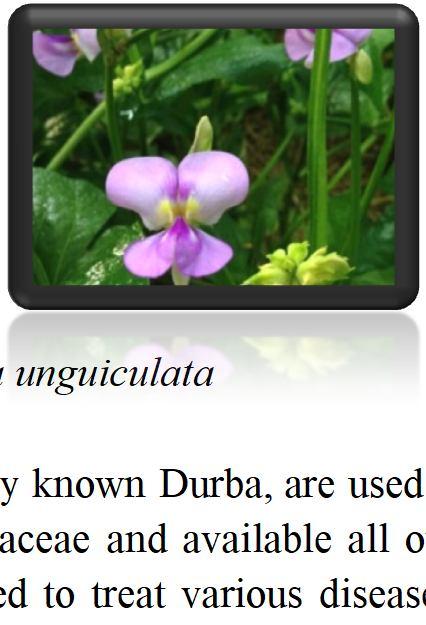

Our earth is a rich source of medicinal plant [1 ]. mainly known Durba, are used both externally and internally for various medicinal value[ Cynodon dactylon family Poaceae and available all over the country[ Different parts extract of the plant such as leaves, roots, stems, fruits, seeds are used to treat various disease due to presence of different phytochemical components and plants[16] The Plant extract shows antiviral and antimicrobial activity[17].
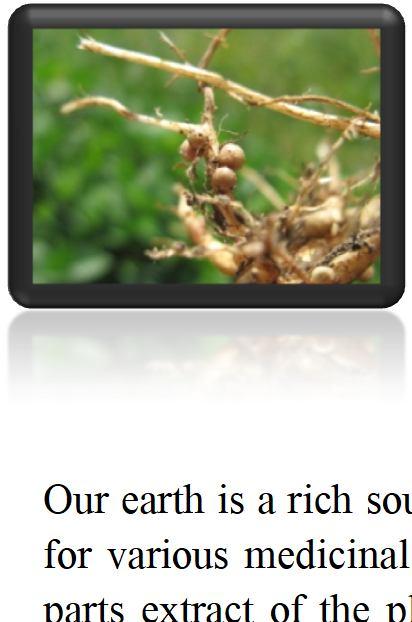
ISSN: 2321 9653; IC Value: 45.98; SJ Impact Factor: 7.538 Volume 10 Issue VIII Aug 2022 Available at www.ijraset.com

The plant shows positive response against snake bites, gout and rheumatic affection[18] In Homeopathic medicine Cynodon dactylon is used in bleeding and skin troubles.[19,20] C.dactylon is grew in warm climates and all around the year[21,22] Completely herb and its root stalk is used in medicine[23] The gray or green leaf blades of Cynodon dactylon are, 2 15cm long and 4mm broad. Leafs are flat to slightly keeled, tip
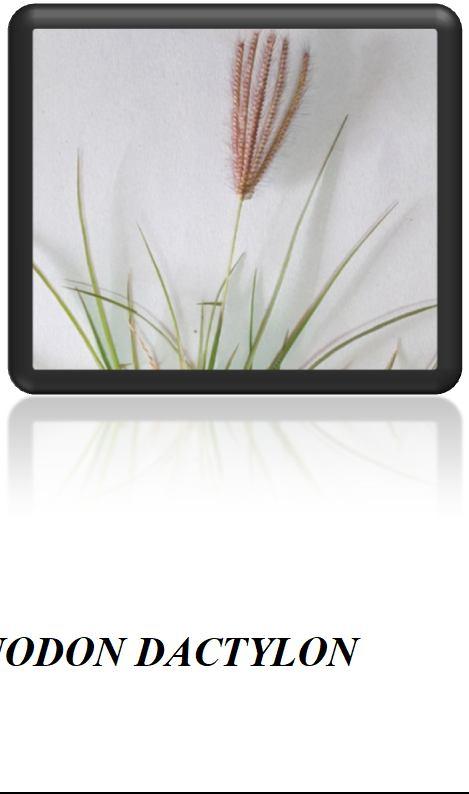
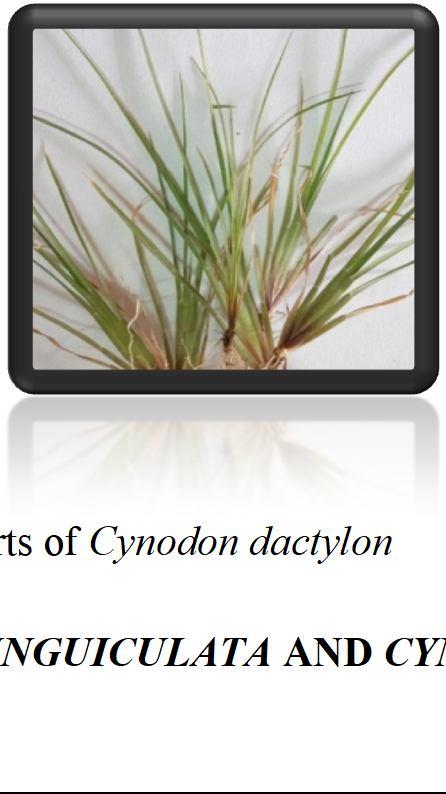
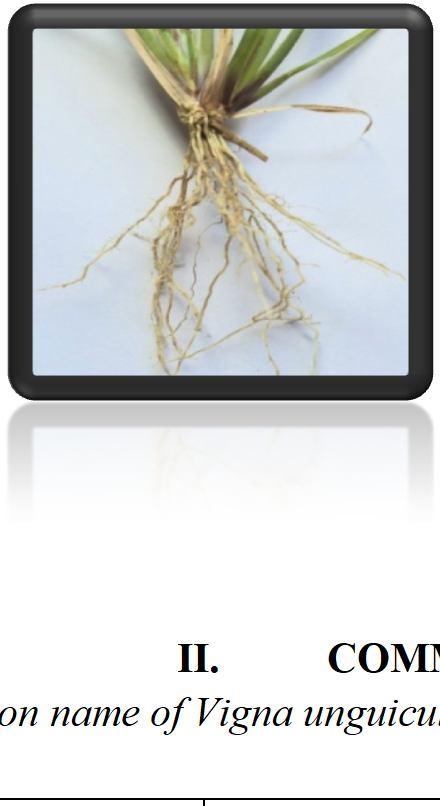

and glabrous. Cynodon dactylon flowers are spikelets with a perfect floret and lanceolate and yellow in
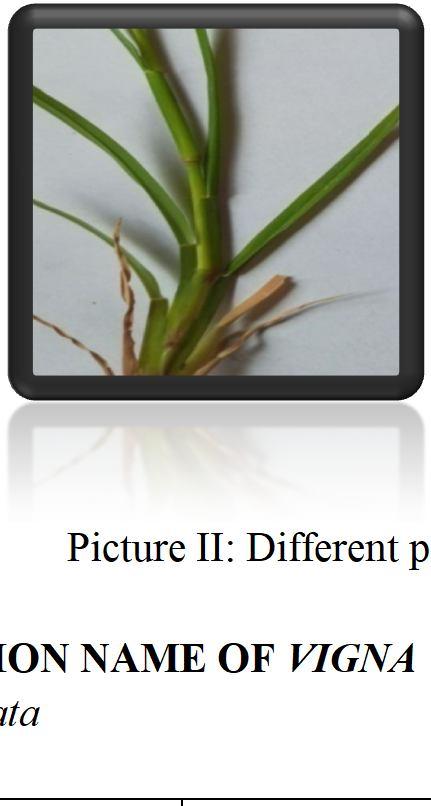
seeds are oval and about 1.5 mm long[24]
Picture II: Different parts of
COMMON NAME OF VIGNA UNGUICULATA CYNODON DACTYLON
Table

III. SYSTEMIC CLASSIFICATION OF VIGNA UNGUICULATA AND CYNODON DACTYLON

IV. PHYTOCHEMICAL CONSTITUENTS OF VIGNA UNGUICULATA AND CYNODON DACTYLON
Chemical Name
Sl No Chemical Name References
Proteins, Carbohydrates, Vitamin C, Terpenoids, alkaloids,
Flavonoids:apigenin, orientin, letuolin, and vitexin

Extractive Value (water: 18.88,
ether:3%, alcohol;8% and
30.46% and tannin content: 0.80%. Total Ash: 9.1%, water insoluble ash: 7.9%, acid insoluble ash:3.7%.
grass (dry0 10.47% crude protein,11.755 total ash, 28.17%fiber.
glycerin (38.49%), 9, 12 octadecadienoyl chloride, (Z,Z) (15.61%), ethyl ester (9.50), hexadecanoic acid, phytol (4.89%) and

: furfural (6.0%), hydro quinone (69.49%) and
(2.72%).
ISSN: 2321 9653; IC Value: 45.98; SJ Impact Factor: 7.538 Volume 10 Issue VIII Aug 2022 Available at www.ijraset.com

V. PHARMACOLOGICAL ACTIVITIES OF VIGNA UNGUICULATA AND CYNODON DACTYLON
A. Pharmacological Activities of Vigna unguiculata
Plant Parts Extracts
Seeds Aqueous
Biological Activities
References
Antibacterial activity, 54 Hepatoprotective
Seeds Ethanol Anthelminthic Activity,
Anti atherosclerotic
Antisickling Activity 58.59 Hypolipidimic Activity
Seeds Methanol Antioxident
Antibacterial
Antinociceptive Activity
Antidiabetic
Thrombolytic Activity
Hypocholesterolemic Activity, Hypoglycemic
Hypoglycemic
Seeds HIV 1 reverse transcriptase and α glucosidase inhibitor
Antiparasitic
Seed oil Antimicrobial
Antidiabetic
Leaves Ethanol Antimicrobial
Diuretics
Antisickling Activity 74
Leaves Antihyperlipidemic, cardioprotective
Whole Plant Methanol Antiobesity
Whole Plant Antidiabetic
Table VI : Pharmacological activity of Vigna unguiculata
B. Pharmacological Activities of Cynodon dactylon
Plant Parts Solvents
Aqueous
Whole plant
Aqueous and non polysaccharide fraction
Chloroform methanolic
Pharmacological Activity References
Antipyretic and analgesic
Anthelmintic
Anticataleptic
Anti inflammatory
Anti diabetic
inflammatory
Ethanolic Anticonvulsant

50% ethanolic
inflammatory
Methanolic Anti diarrheal
Aqueous and Wound healing
Aerial parts
& Engineering Technology
ISSN: 2321 9653; IC Value: 45.98; SJ Impact Factor: 7.538 Volume 10 Issue VIII Aug 2022 Available at www.ijraset.com

ethanolic Anti diabetic
90 50% aqueous ethanolic Reduce kidney stone
Ethanolic Gastoprotective
Central Nervous system
Ethyl acetate fraction Antioxidant
Hydroalcoholic Antioxidant
Rhizome Aqueous Anti diuretic
Hydroalcoholic Anti arrhythmic
Cardio protective
Leaves Aqueous and Chlroform
Antimicrobial
Anti diabetic
Aqueous and ethanolic Antiepileptic
Ethyl acetate fraction Antioxidant
Immunomodulatory
Phospate buffered saline Antilipidperoxidative

Roots Methanolic Anticancer
Table VII : Pharmacological activity of Cynodon dactylon
VI. ANTI MICROBIAL ACTIVITIES OF VIGNA UNGUICULATA AND CYNODON DACTYLON A. Anti Microbial Activity of Vigna unguiculata Vigna unguiculata seed oil shows positive antimicrobial activity at the concentration of 400 µg/ disc showed the highest activity against Gram positive bacteria like Sarcina lutea and Staphylococcus aureus as well as Vigna unguiculata seed oils are active against numerous fungi namely Penicilium spp., Mucor spp. and Candida albicans [70].
The antimicrobial activity of three varieties ofVigna unguiculata L. Walp seed oil (LBS 1, LBS 2 and LBS 3) were investigated against five Gram positive bacteria (Bacillus megaterium, Bacillus subtilis, Sarcina lutea, Salmonella typhi and Staphylococcus aureus) and four Gram negative (Escherichia coli, Shigella dysenteriae, Shigella sonnei, Shigella shiga) and four fungi (Penicilium spp., Mucor spp., Candida albicans and Aspergillus fumigatius). The LBS 1 oil at the co ncentration of 400 µg/ disc showed the highest activity against Sarcina lutea ( 19±0.1 mm) than that of LBS 2 (14±0.3 mm) and LBS 3 (12±0.3 mm) oil whereas LBS 3 oil showed highest activity against Staphylococcus aureus (16±0.1 mm)than that of LBS 1 (10±0.6 mm)and LBS 2 (13±0.4 mm) oil. All the three oils are active against the three tested fungi namely Penicilium spp., Mucor spp. and Candida albicans but showed no sensitivity against Aspergillus fumigatius
The antimicrobial activity of three varieties ofVigna unguiculata L. Walp seed oil (LBS 1, LBS 2 and LBS 3) were investigated against five Gram positive bacteria (Bacillus megaterium, Bacillus subtilis, Sarcina lutea, Salmonella typhi and Staphylococcus aureus) and four Gram negative (Escherichia coli, Shigella dysenteriae, Shigella sonnei,
Factor
International Journal for Research in Applied Science & Engineering Technology (IJRASET)

ISSN: 2321 9653; IC Value: 45.98; SJ Impact Factor: 7.538 Volume 10 Issue VIII Aug 2022 Available at www.ijraset.com
Shigella shiga) and four fungi (Penicilium spp., Mucor spp., Candida albicans and Aspergillus fumigatius). The LBS 1 oil atthe concentration of400 µg/ disc showed the highest activity against Sarcina lutea ( 19±0.1 mm) than that of LBS 2 (14±0.3 mm) and LBS 3 (12±0.3 mm) oil whereas LBS 3oil showed highest activity against Staphylococcus aureus (16±0.1 mm)than that of LBS 1 (10±0.6 mm)and LBS 2 (13±0.4 mm) oil. All the three oils are active against the three tested fungi namely Penicilium spp., Mucor spp. and Candida albicans but showed no sensitivity against Aspergillus fumigatius
B. Anti Microbial Activity Cynodon dactylon Chloroform and aqueous extract of Cynodon dactylon leaves shows antibacterial activity against tested gram positive (Pseudomonas aeruginosa and Staphylococcus aureus) and gram negative (Escherichia coli and Klebsiella pneumoniae) bacteria and 75 µl/ml concentration shows the best result compare than concentration 25 µl/ml and 50 µl/ml [99].
damba J, Nyazema N, Makaza N, Anderson C, Kaondera KC (1994) Traditional herbal remedies used for the treatment of urinary shistosomiasis in Zimbabwe. Journal of Ethnopharmacology 42: 125 132
damba J, Nyazema N, Makaza N, Anderson C, Kaondera KC (1994) Traditional herbal remedies used for the treatment of urinary shistosomiasis in Zimbabwe. Journal of Ethnopharmacology 42: 125 132
damba J, Nyazema N, Makaza N, Anderson C, Kaondera KC (1994) Traditional herbal remedies used for the treatment of urinary shistosomiasis in Zimbabwe. Journal of Ethnopharmacology 42: 125 1
Ndamba J, Nyazema N, Makaza N, Anderson C, Kaondera KC (1994) Traditional herbal remedies used for the treatment of urinary shistosomiasis in Zimbabwe. Journal of Ethnopharmacology 42: 125 13
Ndamba J, Nyazema N, Makaza N, Anderson C, Kaondera KC (1994) Traditional herbal remedies used for the treatment of urinary shistosomiasis in Zimbabwe. Journal of Ethnopharmacology 42: 125 13
Ndamba J, Nyazema N, Makaza N, Anderson C, Kaondera KC (1994) Traditional herbal remedies used for the treatment of urinary shistosomiasis in Zimbabwe. Journal of Ethnopharmacology 42: 125 13
damba J, Nyazema N, Makaza N, Anderson C, Kaondera KC (1994) Traditional herbal remedies used for the treatment of urinary shistosomiasis in Zimbabwe. Journal of Ethnopharmacology 42: 125 132
damba J, Nyazema N, Makaza N, Anderson C, Kaondera KC (1994) Traditional herbal remedies used for the treatment of urinary shistosomiasis in Zimbabwe. Journal of Ethnopharmacology 42: 125 132
amba J, Nyazema N, Makaza N, Anderson C, Kaondera KC (1994) Traditional herbal remedies used for the treatment of urinary shistosomiasis in Zimbabwe. Journal of
Impact Factor 7.538
Impact Factor 7.894

International Journal for Research in Applied Science & Engineering Technology (IJRASET)

ISSN: 2321 9653; IC Value: 45.98; SJ Impact Factor: 7.538
Volume 10 Issue VIII Aug 2022 Available at www.ijraset.com
Ethnopharmacology 42: 125 132

Ndamba J, Nyazema N, Makaza N, Anderson C, Kaondera KC (1994) Traditional herbal remedies used for the treatment of urinary shistosomiasis in Zimbabwe. Journal of Ethnopharmacology 42: 125 132
VII. CONCLUSION
Vigna unguiculata (Cowpea) and Cynodon dactylon is very important and extremely useful in ayurvedic, unani and siddha medicine From ancient days. Both plants are found all over the year and very easily and both plants are shows near about result in antimicrobial activity. Vigna unguiculata (Cowpea) extract at concentration 400 µg/ disc shows antimicrobial activity against gram positive, gram negative and different types of fungi. Others important activity like thrombolytic and antisickling activities, anthelmintic, antilipidemic, antidiabetic, antibacterial, antifungal, antiviral, antioxidant due to rich source of vitamin A, vitamin C, flavonoids, riboflavin, zinc, copper, magnesium, calcium, sodium, phosphorus, thiamine, amino acid, phytic acid, alkaloids, saponins, fats, resins, terpenoids, glycosides in the different parts of the plant. Different parts of Cynodon dactylon plants contain different types of phytochemical like proteins, minerals, carbohydrates, vitamin C, terpenoids, alkaloids and palmitic acid, Flavonoids: apigenin, orientin, letuolin, and vitexin. Cynodon dactylon have significant role in management of diabetics and cardiovascular disease as well as 75 µl/ml concentration shows the best result in antimicrobial activity.
Conflict of Interest: Nil
amba J, Nyazema N, Makaza N, Anderson C, Kaondera KC (1994) Traditional herbal remedies used for the treatment of urinary shistosomiasis in Zimbabwe. Journal of Ethnopharmacology 42: 125 132
amba J, Nyazema N, Makaza N, Anderson C, Kaondera KC (1994) Traditional herbal remedies used for the treatment of urinary shistosomiasis in Zimbabwe. Journal of Ethnopharmacology 42: 125 132
Ndamba J, Nyazema N, Makaza N, Anderson C, Kaondera KC (1994) Traditional herbal remedies used for the treatment of urinary shistosomiasis in Zimbabwe. Journal of Ethnopharmacology 42: 125 132
Ndamba J, Nyazema N, Makaza N, Anderson C, Kaondera KC (1994) Traditional herbal remedies used for the treatment of urinary shistosomiasis in Zimbabwe. Journal of Ethnopharmacology 42: 125 132
Ndamba J, Nyazema N, Makaza N, Anderson C, Kaondera KC (1994) Traditional herbal remedies used for the treatment of urinary shistosomiasis in Zimbabwe. Journal of Ethnopharmacology 42: 125 132
Ndamba J, Nyazema N, Makaza N, Anderson C, Kaondera KC (1994) Traditional herbal remedies used for the treatment of urinary shistosomiasis in Zimbabwe. Journal of Ethnopharmacology 42: 125 132
REFERENCES
[1] Nweke, K. World literature on cowpea (Vigna unguiculata (L.) Walp). Annals of Library Science and Documentation; 1988; 35(1): 26 31.
[2] Ogunlade I, Ogunleye R T, Osasona I. Chemical Composition, Antioxidant Capacity and Total Phenolic Content of the Flours Obtained from Cow Pea (Vigna ungualata) Varieties Commonly Consumed in Nigeria; 2014; 5.
[3] Bejarano A, Ramírez Bahena M H, Velázquez E, Peix A. Vigna unguiculata is nodulated in Spain by endosymbionts of Genisteae legumes and by a new symbiovar (vignae) of the genus Bradyrhizobium. Systematic and Applied Microbiology; 2014; 37(7): 533 540.
All Rights are Reserved | SJ Impact Factor 7.538 | ISRA Journal Impact Factor 7.894 |
International Journal for Research in Applied Science & Engineering Technology (IJRASET)

ISSN: 2321 9653; IC Value: 45.98; SJ Impact Factor: 7.538 Volume 10 Issue VIII Aug 2022 Available at www.ijraset.com
[4] Segura Campos M R, Chel Guerrero L A, Betancur Ancona D A. Purification of angiotensin I converting enzyme inhibitory peptides from a cowpea (Vigna unguiculata) enzymatic hydrolysate. Process Biochemistry; 2011; 46(4): 864 872.
[5] Agugo U A, Okere T O, Anya K M. Investigating the nutrient composition and anti nutritional factors of Akidi (Vigna unguiculata), IOSR; 2013; 5(4): 3235.
[6] Gupta N et al Phytochemical evaluation of Moth Bean (Vigna aconitifolia L.) seeds and their divergence. Biochemistry Research International; 2016; 6.
[7] Ibrahim S et al. Pharmacological activities of Vigna unguiculata (L) Walp: A review. International Journal of Pharma and Chemical Research; 2017; 3(1): 44 49
[8] Siddhuraju P., Becker K. The antioxidant and free radical scavenging activities of processed Vigna Unguiculata (L) Walp seed extracts.Food Chem; 2007; 101(1):10 9.
[9] Boukar, O. et al., “Cowpea”, in: De Ron, A.M. (ed.), Grain Legumes, Series Handbook of Plant Breeding, Springer Verlag, New York, 2015; pp. 219 250.
[10] Barnard, E.A. Ribonucleases. Annual review of biochemistry, 1969; 38(1), 677 732.

[11] Can M, Kaymak G, Sahin M., Acar Z., Ayan I. Chapter 4 Forage Cowpea (Vigna Unguiculata L. Walp) 2021
[12] Chakraborty S, Pal R, Bhattacharya S, Mandal C, Bhattacharjee A; A Short Review on Vigna unguiculata: A God Gifted Plant in Management of Sickling of Red Blood Cell and Thrombolysis; IJCRT; 2022; 10(7) : d406 d413
[13] Nagori BP, Renu S; Cynodon dactylon (L.) Pers.; a Valuable Medicinal Plant; Research Journal of Medicinal Plant; 2011; 5(5): 508 514;
[14] Shendye NV, Gurav SS; Cynodon dactylon: A Systemic Review of Pharmacognosy, Phytochemistry and Pharmacology; Int J Pharm Pharm Sci; 2014; 6(8): 7 12.
[15] Animesh DK, Rita P, Aninda M; An updated overview on Cynodon dactylon (L) Pers.; Int J res Ayuerveda Pharm; 2012; 3(1): 11 14.
[16] Rai PK, Rai NK, Rai AK, Watal G; Role of LIBS in elemental analysis of Psidium guajava responsible for glycemic potential; Inst Sci Tech; 2007; 35: 507 522.
[17] Dhar ML, Dhwan JT, Melhorta M; Screening of Indian Plants For Biological activity; Ind J exp Biol; 1968; 6(4): 232 247.
[18] Chopra RN, Nayer SL, Chopra IC; CSIR, New Delhi: Publication and Information Directorte; J Glossary of Indian Medicinal plants; 1999 88.
[19] Ghosh N.C. Comparative Materia Medica. Hannemann Pub., Co. Pvt. Ltd.; 1998; pp: 855.
[20] Oudhia P, Joshi BS, Kosta VK; The possibilities of preparing homeopathic drugs from the obnoxious weeds of Chhattisgarh; Bhartiya Krishi Anusandhan Patrika; 1998; 13: 53 57.
[21] Kaup SR, Nayantara AK, Bernhardt LK, Vasavi RG, Shetty SS, Pai SR; Arun KB; Antihyperlipidemic activity of Cynodon dactylon extract in high cholesterol diet fed Wistar rats; J Genom Med Biom Health Sci; 2011; 3(3 4): 98 102.
[22] Chandra MD, Shama S, Satish C; Overview of Cynodont dactylon in modern medicine as antidiabetic herb; Journal of drug delivery &Theraputics; 2013, 3(6), 117 120.
[23] Kritikar, KR, Basu BD; 1980; Indian medicinal Plants, 2nd Edn.; International book distributors, Dehradun; pp. 2650.
[24] Mandal C, Chakraborty S, Bhattacharya S, Pal R, Bhattacharjee A, A Comprehensive Review on Cynodon dactylon in Management of Diabetes & Cardiovascular Diseases; IJPRA ; 2022 ; 7(4) : 624 633
[25] Singh A et al. Review on standardization and phytochemical of Vigna unguiculata. International Journal for Pharmaceutical Research Scholars. 2015; 4(2):506 516.
[26] Heuzé V, Tran G. Cowpea (Vigna unguiculata) seeds. Feedipedia, a programme by INRA, CIRAD, AFZ and FAO, 2015.
[27] Gupta N et al. Phytochemical evaluation of Moth Bean (Vigna aconitifolia L.) seeds and their divergence. Biochemistry Research International; 2016; 6.
[28] Ashraduzzaman M et al. Vigna unguiculata Linn. Walp. seed oil exhibiting antidiabetic effects in alloxan induced diabetic rats. Malaysian Journal of Pharmaceutical Sciences. 2011; 9(1):13 23.
[29] Asthana A, Anil K, Sumit G and Jyotsna D. Pharmacological perspectives of Cynodondactylon. Res. J. Pharma. Biol. Chem. Sci. 2012; 3(2):1135 1147.
[30] Chandra MD and Chandra SS; overview of cynodont dactylon in modern medicine as antidiabetic herb; Journal of drug delivery &Theraputics; 2013, 3(6), 117 120.
[31] Singh SK, Rai PK, Mehta S, Gupta RK and Watal G. Curative effect of Cynodon dactylon against STZ induced hepatic injury in diabetic rats. Ind. J. Clin. Biochem. 2009; 24:410 413
[32] Sathe, SK. and Venkatachalam M. Fractionation and biochemical characterization of moth bean (Vigna aconitifolia) proteins. LWT Food Science and Technology. 2007; 40(4), 600 610.
[33] Ibrahim S et al. Pharmacological activities of Vigna unguiculata (L) Walp: A review. International Journal of Pharma and Chemical Research. 2017; 3(1):44 49.
[34] Kumar A, Sawarkar HA, Deshmukh VS, Mishra KK, Singh M, Verma T and Kashyap P.Cynodondactylon(L.) Pers: Pharmacological actions and medicinal applications International Journal of Herbal Drug Research; 2011; I(1): 1 7.
[35] Shendye NV and Shailendra S.,Cynodondactylon: A systemic review of pharmacognosy, phytochemistry and pharmacology; International Journal of Pharmacy and Pharmaceutical Sciences; 2014, 6(8), 7 12
[36] Chandra Mukesh D., Shamashilpand Satish Chandra.; overview of cynodont dactylon in modern medicine as antidiabetic herb; Journal of drug delivery &Theraputics; 2013, 3(6) : 117 120
[37] Onwuliri VA, Obu JA. Lipids and other constituents of Vigna unguiculata and Phaseolus vulgaris grown in northern Nigeria. Food Chem.2002; 78(1):1 7
[38] Ibrahim.Sayeed.VK., S.S. Satish., Kumar Ajay and Karunakara Hegde.; pharmacological activities of Vigna unguiculata a review; ISSN; 2395 3411, 44
[39] Solanki R, Nagori BP. Physicochemical and phytochemical investigation of whole plant of Cynodondactylon. Int. J. Comp. Pharm. 2012; 3(10):1 4 [40] Nair GA. Flavonoids of Cynodon dactylon. J. Med. Ethnobot. Res. 1995; 16(3 4):153 157.
[41] AvvaraiSK, Kattamanchi G, Doni K, Anugu MR, Raju C. Anti diabetic activity of ethanolic extract of Cynodon dactylon root stalks in streptozotocin induced diabetic rats. Int. J. Adv. Pharm. Res. 2011; 2(8):418 422.
[42] Chapman GW, Burdick D, Higman HC, Robertson JA. Steam volatiles from coastal Bermuda grass. J. Sci. Food. Agric. 1978; 29(4):312 316.
[43] Singh V.Anatomical and phytochemical study on Durva (Cynodondactylon Linn, Pers) An ayurvedic drug International Ayurvedic Medical Journal 2013; 1(5): 1 7
[44] Snafi Al Dr Ali Esmail.; Chemical constituents and pharmacological effects of Cynodondactylon A Review; IOSR Journal of Pharmacy. 2016; 6(7):16 31
Factor
Factor 7.894
Journal for Research in Applied Science & Engineering Technology (IJRASET)

ISSN: 2321 9653; IC Value: 45.98; SJ Impact Factor: 7.538 Volume 10 Issue VIII Aug 2022 Available at www.ijraset.com
[45] Paranjpe P. Durva. In: Indian Medicinal Plants: Forgotten Healers. 1st Edn, Chaukhamba Sanskrit Pratishthan, Delhi. 2001; pp. 75 76.
[46] Jananie RK, Priya V, Vijayalakshmi K. Determination of Bioactive Components of Cynodondactylon by GC MS Analysis. New York Sci. J. 2011; 4(4):16 20.
[47] Mohamed Shabi M, Gayathri K, Venkatalakshmi R, Sasikala C. Chemical Constituents of hydro alcoholic extract and Phenolic fraction of Cynodondactylon. Int. J. Chem Tech. Res. 2010; 2(1):149 154.
[48] Chou CH, Young CC. Phytotoxic substances in twelve subtropical grasses. J. Chem. Ecol. 1975; 1(2):183 193.
[49] AvvaraiSK, Kattamanchi G, Doni K, Anugu MR, Raju C. Anti diabetic activity of ethanolic extract of Cynodondactylon root stalks in streptozotocin induced diabetic rats. Int. J. Adv. Pharm. Res. 2011; 2(8):418 422.
[50] Chandel E and Kumar B. Antimicrobial activity and phytochemical analysis of Cynodondactylon: A review. World Journal of Pharmacy and Pharmaceutical Sciences 2015; 4(11): 515 530.
[51] Chandra Mukesh D., Shamashilpand Satish Chandra.; overview of cynodont dactylon in modern medicine as antidiabetic herb; Journal of drug delivery &Theraputics; 2013, 3(6), 117 120.
[52] Trease And Evans, Textbook of Pharmacognosy, Elsevier; 15th ed. p. 204 205, 479.
[53] The wealth of India 2nd supplement series, Raw materials, CSIR, Vol. 1 page no.331 33
[54] Sandeep D. Evaluation of Antibacterial activity of seed extract of Vigna unguiculata. International Journal of Pharmacy and Pharmaceutical Sciences; 2014; 6(1):75 77.
[55] Ibrahim S et al. Hepatoprotective potential of aqueous extract of Vigna unguiculata (L) Walp seeds against paracetamol induced hepatotoxicity in rats. International Journal of Pharma and Chemical Research; 2017; 3(3):456 461.
[56] Maisale B et al. Phytochemical properties and anthelmintic activity of Vigna unguiculata Linn. Journal of Pharmaceutical and Scientific Innovation. 2012; 1(2):51 52.

[57] Azizah I et al. The effects of Vigna unguiculata on aortic endothelial cells, endothelial nitric oxide synthase expression, lipid profile, and atherosclerosis in ovariectomized rats. Journal of Experimental and Integrative Medicine; 4(3):207 211.
[58] Egba I S, Emmanuel N T, Ogugua N V, Ndohnui N N. Antisickling potential of the ethanol seed extracts of Vigna Unguiculata and Vigna Subterranean. International Journal of Biochemistry and Biotechnology; 2012; 1(9): 226 229.
[59] Kitadi JM. et.a. Mineral Content and Antisickling Activity of Annona senegalensis, Alchornea cordifolia and Vigna unguiculata Used in the Management of Scikle cell disease in the Kwilu province (Congo, DR). International Blood Research and Reviews, 2020; 11(3): 18 27.
[60] Allah NSK et al. Phytochemical screening and hypolipidemic activity of extracts from seeds and leaves of Vigna unguiculata growing in Sudan. Journal of Pharmacognosy and Phytochemistry; 2017; 6(3):488 491.
[61] Zia Ul Haq M et al. Antioxidant activity of the extracts of some cowpea (Vigna unguiculata (L) Walp.) cultivars commonly consumed in Pakistan. Molecules; 2013; 18(2):2005 2017.
[62] Siddhuraju P, Becker K. The antioxidant and free radical scavenging activities of processed cowpea (Vigna unguiculata (L.) Walp.) Seed extracts. Food Chemistry; 2007; 101(1):10 19.
[63] Chaurasia S, Saxena R. Antibacterial activity of four different varieties of green beans. Research Journal of Pharmaceutical, Biological and Chemical Sciences; 2012; 3(3):70 74.
[64] Tazin TQ, Rumi JF, Rahman S, AlNahain A, Jahan R, Rahmatullah M. Oral glucose tolerance and antinociceptive activity evaluation of methanolic extract of Vigna unguiculata. World journal of pharmacy and pharmaceutical sciences; 2014; 3(8): 28 37.
[65] Hussain MS et al. In vitro thrombolytic potentials of methanolic extract of Vigna unguiculata Linn (seed). Journal of Pharmacognosy and Phytochemistry; 2016; 5(3):129 131.
[66] Weththasinghe P et al. Hypocholesterolemic and hypoglycemic effect of cowpea (Vigna unguiculata L. Walp) incorporated experimental diets in wistar rats (Rattus norvegicus). Agriculture and Agricultural Science Procedia; 2014; 2:401 405.
[67] Weththasinghe P, Liyanage R, Vidanarachchi J, Perera O, Jayawardana B. Hypocholesteolemic and Hypoglycemic effect of Cowpea (Vigna Unguiculata (L) Walp) incorporated experimental diets in Wistar rats (Rattus Norvegcus).Agriculture and Agricultural Science Procedia; 2014; 2: 401 405.
[68] Ye X, Wang H and Ng T. Structurally dissimilar proteins with antiviral and antifungal potency from cowpea (Vigna unguiculata) seeds. Life Sciences; 2000; 67(26):3199 3207.
[69] Souza GS et al. Activity of recombinant and natural defensins from Vigna unguiculata seeds against Leishmania amazonensis. Experimental Parasitology. 2013; 135(1):116 125.
[70] Ashraduzzaman M et al. Antimicrobial Activity of Vigna unguiculata L. Walp Seed Oil. International Journal of Biotechnology for Wellness Industries; 2016; 5(3):70 75.
[71] Ashraduzzaman MD, Alam MA, Khatun S, Banu S, Absar N. Vigna unguiculata Linn. Walp. Seed oil exhibiting antidiabetic effects in alloxan induced diabetic rats. Malaysian journal of pharmaceutical sciences; 2011; 9(1): 13 23
[72] Kritzinger Q et al. Antimicrobial activity of cowpea (Vigna unguiculata) leaf extracts. South African Journal of Botany; 2005; 71(1):45 48.
[73] Chnadrasekaran S, Rajkishore VB, Ramalingam R. Evaluation of diuretic activity on the leaves of Vigna unguiculata. International Journal of Advanced Research and Development; 2016; 1(4):98 100.
[74] Mpiana P et al. In vitro antisickling activity of anthocyanins extracts of Vigna unguiculata (L.) Walp. Chemistry and Medicinal Value; 2009; 25:91 98.
[75] Janeesh P, Abraham A. Vigna unguiculata modulates cholesterol induced cardiac markers, genotoxicity and gene expressions profile in an experimental rabbit model. Food & Function; 2013; 4(4):568 574.
[76] Nderitu KW et al. 2017. Antiobesity activities of methanolic extracts of Amaranthus dubius, Cucurbita pepo, and Vigna unguiculata in progesterone induced obese mice. Evidence Based Complementary and Alternative Medicine; 10.
[77] Barnes M, Uruakpa F, Udenigwe C. Influence of cowpea (Vigna unguiculata) peptides on insulin resistance. Journal of Nutritional Health & Food Science; 2015; 3(2):1 3
[78] Chaudhari Y, Mody H, Acharya B; Antibacterial activity of Cynodondactylon on different bacterial pathogens isolated from clinical samples; Int J Pharm Studies Res; 2011; 2(1): 16 20.
Factor
Journal for Research in Applied Science & Engineering Technology (IJRASET

ISSN: 2321 9653; IC Value: 45.98; SJ Impact Factor: 7.538 Volume 10 Issue VIII Aug 2022 Available at www.ijraset.com
[79] Garg VK, Khosa RL; Analgesic and anti pyretic activity of aqueous extract of Cynodon dactylon; Pharmacologyonline; 2008; 3: 12 18.
[80] Abhishek B, Anita T; Anthelmintic activity of Cynodon dactylon; Journal of Pharmacognosy and Phytochemistry; 2012; 1(3): 1 3.
[81] Dhande SR; Anti inflammatory and analgesic properties of the 50% ethanolic extract of Cynodon dactylon; Int Res J Invent Pharm Sci; 2013; 1: 8 16
[82] Jarald, EE, Joshi SB, Jain DC; Antidiabetic activity of aqueous extract and non polysaccharide fraction of Cynodon dactylon Pers; Indian J Exp Bio; 2008; 46(9): 660 667.
[83] Sharma N, Rana AC, Bafna P; Effect of aqueous extract of Cynodon dactylon on reserpine induced catalepsy; Int J Pharm Pharm Sci; 2011; 3(4): 424 426.
[84] Pal DK; Determination of brain biogenic amines in Cynodon dactylon L. (Pers) and Cyperus rotundus L. treated mice; Int J Pharm Pharm Sci; 2009; 1(1): 190 197.
[85] Garg VK, Paliwal SK; Anti inflammatory activity of aqueous extract of Cynodon dactylon; Int J Pharmacol; 2011; 7(3): 370 375.
[86] Yogesh HS, Kidchadi SCK, Muchandi IS, Gopalakrishna B; Evaluation of Anti Inflammatory activity of Cynodondactylon Pers. On carrageenan induced paw edema in rats. Indian Journal of National Product and Resources 2013; 4(2): 151 154.
[87] Yogesh HS, Kidchadi SCK, Muchandi IS, Gopalakrishna B; Evaluation of Anti Inflammatory activity of Cynodondactylon Pers. On carrageenan induced paw edema in rats. Indian Journal of National Product and Resources 2013; 4(2): 151 154.
[88] Singh, SK, Kesari AN, Gupta RK, Jaiswal D, Watal G; Assessment of antidiabetic potential of Cynodon dactylon extract in streptozotocin diabetic rats; J Ethnopharmacol, 2007; 114: 174 179

[89] Singh SK, Rai PK, Jaiswal D,Watal G; Evidence based critical evaluation of glycemic potential of Cynodon dactylon; Evidence Based Complementary Alter Med, 2008; 5(4): 415 420.
[90] Mahesh N, Brahatheeswaran D; Anti hyperglycemic activities of aqueous and ethanolic extracts Cynodon dactylon (Linn) streptozotocin induced diabetic rats; Asian J Biochem; 2007; 2(1): 66 72.
[91] Dande P, Khan A; Evaluation of wound healing potential of Cynodon dactylon; Asian Journal of Pharmaceutical and Clinical Research; 2012; 5(3): 161 164.
[92] Yogesh HS, Kidchadi SCK, Muchandi IS, Gopalakrishna B; Evaluation of Anti Inflammatory activity of Cynodondactylon Pers. On carrageenan induced paw edema in rats. Indian Journal of National Product and Resources 2013; 4(2): 151 154.
[93] Pal DK., Mandal M., Senthilkuma GP., Padhiary A; Evaluation of CNS activities of aerial parts of Cynodon dactylon Pers. in mice; Acta Pol Pharmaceutica; 2008; 65(1): 37 43.
[94] Saradha DKM, Annapoorani S, Ashokkumar K; Hepatic antioxidative potential of ethyl acetate fraction of Cynodon dactylon in Balb/c mice; J Med Plant Res; 2011; 5(6): 992 996
[95] Hajzadeh MR, Fatemeh BR, Abolfazl K, Alireza M; The Effects of N butanol Fraction and N butanol Phase Remnant From 50% Aqueous Ethanolic Extract of Cyndon dactylon on Calcium Oxalate Kidney Stones in Rat; Pharmacognosy Research; 2009; 1(6): 431 434.
[96] Sadki C, Atmani F; Acute diuretic activity of aqueous Erica multiflora flowers and Cynodon dactylon rhizomes extracts in rats; J Ethnopharmacol; 2010; 128(2): 352 356.
[97] Najafi, M, Nazemiyeh H, Ghavimi H, Gharakhani A, Garjani A; Effects of hydroalcoholic extract of Cynodon dactylon (L.) pers. on ischemia/reperfusion induced arrhythmias; DARU, 2008; 16(4): 233 238.
[98] Garjani A, Afrooziyan A, Nazemiyeh H, Najafi M, Kharazmkia A, Maleki Dizaji N; Protective effects of hydroalcoholic extract from rhizomes of Cynodon dactylon (L.) Pers. on compensated right heart failure in rats; BMC Complementary & Alternative Medicine; 2009; 9: 1 9
[99] Suresh K, Deepa P, Harisaranraj R, Vaira Achudhan V; Antimicrobial and Phytochemical investigation of the leaves of Carica papaya L., Cynodondactylon (L.) Pers., Euphorbia hirta L., Melia azedarach L. and Psidium guajava L.; J Ethnobotanical Leaflets; 2008; 12: 1184 91.
[100]Karthik S, Ravikumar A; Study on the protective effect of Cynodon dactylon leaves extract in diabetic rats; Biomedical and Environmental Science; 2011; 24(2): 190‐199
[101]Venkateswarlu G, Edukondalu K, Chennalakshmi BGV, Sambasivarao P, Raveendra G, Ramanarayana V; Evaluation of Antiepileptic activity of leaf extract of Cynodon dactylon (L.) Pers. in validated animal models; International Journal of Current pharmaceutical Research; 2012; 2(3): 571 579.
[102]Saradha DKM, Annapoorani S, Ashokkumar K; Evaluation of the immunomodulatory activities for ethyl acetate fraction of Cynodondactylon in Balb/c mice; Journal of Agricultural Science; 2011; 3(3): 182 185.
[103]Santhi R, Kalaiselvi K, Annapoorani S; Anti lipid peroxidative activities of Cynodondactylon and Moringa oleifera against ELA induced mice; Pharmacologyonline; 2009; 3: 544 549.
[104]Albert baskar A, Ignacimuthu S; Chemoprotective activity of C. dactylon L. (Pers) extract against DMH induced colon carcinogenesis in experimental animals; Exp Toxicol Pathol; 2010; 62(4): 423 431.

